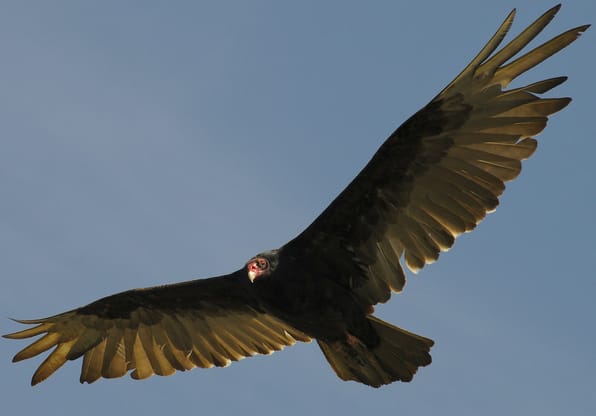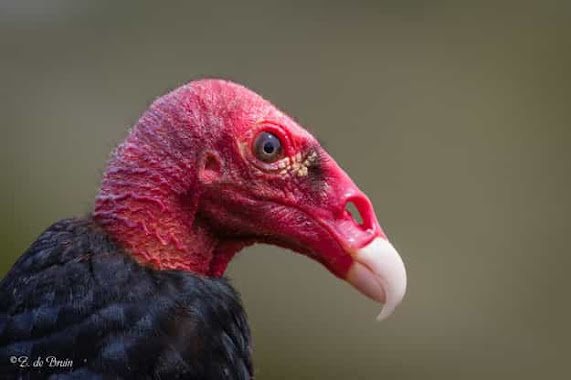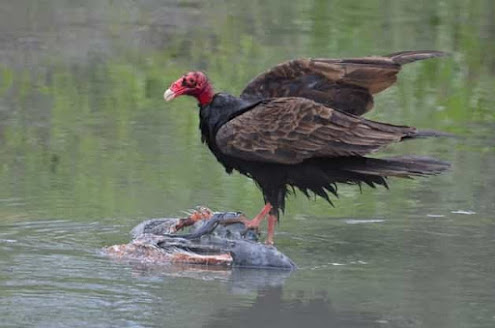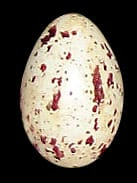"Turkey Vulture"

Turkey vulture or turkey buzzard is a large raptor and the most widespread vulture in North America. The scientific name of Turkey Vulture is Cathartes aura and it also belongs to the family Cathartidae. The word Cathartidae comes from a Greek word Cathartes, means “purifier”. This New World scavenging birds are found from Americas to southern Canada. When turkey vulture stands on the ground resemble a wild turkey. Turkey vulture gets its common name for its dark plumage and red bald head. Its red head is similar to wild turkey. The word vulture comes from a Latin word “vulture” which means “tearer”. Carl Linnaeus who is called “Father of modern taxonomy”, a Swedish zoologist and botanist, first described the turkey vulture in his “10th edition of Systema Naturae”, published in 1758. Six subspecies of turkey vultures are native to North, South and Central America.
The six subspecies of turkey vulture are:
1.Cathartes aura aura
2.Cathartes aura jota
3.Cathartes aura septentrionalis
4.Cathartes aura meridionalis
5.Cathartes aura falklandicus
6.Cathartes aura ruficollis
Description and Behavior of Turkey Vulture

Turkey vulture has dark brown feathers but a distance, it appears black. Its small red head is featherless and its short-hooked beak is white in color. The underside of their flight feathers is silvery-grey in color. Turkey vulture tail is slim and long.
Adult turkey vulture can grow up to 82cm and weight can reach 1.8 to 5 pounds. Its wingspan will be about 6 feet.
Turkey vultures head is featherless which helps them to clean themselves after eating carrion because they poke their head inside the carcass. So, often they are seen enjoying bating in the nearby water to clean themselves. Their featherless bald head keep them cool in hot weather.
Turkey vulture’s strong hooked beak is pale in color and the irises of the eyes are greyish-brown. Their legs and feet have no feathers and off white in color. Their feet are not so strong and not good for grasping. Their blunt talons are also not good for grasping.
Turkey vulture has ears on the edge of their cheeks, just below the eyes where the bird’s smile is ended and the ears are covered with feathers which are called auriculars.
The eyesight of a turkey vulture is important for the pursuit of food. Their large eyes have thickened retina with higher density of rod cells and cone cells that provide them a superior vision. As their eyes are on either side of their head so they can see a wider field of view.
The turkey vulture is very sensitive to the change of pressure and temperature of air and also the speed of winds. Their legs and feet have fewer nerves so they can stand or perch on hot or cold surfaces.
All vultures including turkey vulture eats carrion or dead animals which have bacteria and toxins but strong and more corrosive stomach acids kill these bacteria and toxins so the vultures do not become ill.
As the turkey vulture has no voice box or syrinx, they cannot call or cackle but they can grunt and hiss. When the Vultures circling overhead to search for carcasses are called a ‘kettle’. When a group of vultures perched in a tree, called a ‘volt’, ‘committee’ or a ‘venue’ and when they feed together on a carcass, they’re called a ‘wake’
The body temperature of the turkey vulture keeps dropping throughout the night so in the morning, they stand with spreading their wings in the sunlight. This pose is called “horaltic pose” that helps them to keep their bodies warm and also dry their plumages after bath.
Turkey vultures urinate on their feet and legs which is called “urohydrosis”, that helps them to keep cool the blood vessels in their legs and feet during hot weather. As their urine is highly acidic, it kills the bacteria which stick on their legs and feet while eating carrion.
Turkey vulture vomit when they are threatened. The bad smell keeps their predators away and also lighten the weight of their body so that they can fly to escape from predators.
Turkey vulture has larger olfactory bulbs with higher number of neurons called mitral cells. These mitral cells received information from small receptors in the nasal cavity and send that information to the rest parts of the brain. Turkey vulture has 3 times more mitral cells in olfactory bulbs than mice or rabbits and can smell of a carcass about 5 miles away.
Turkey vulture able to fly for a long time, about 6 hours without fluttering their wings and per second they do only 1 flap and can travel up to 200 miles in a day. When soaring, turkey vulture hold their wings in a “V” shape.
Their common predators are horned owls, golden eagles, red-tailed hawks and bald eagles and their egg and nestlings are eaten by opossum and raccoons.
Turkey vultures have strong bills but have week feet and blunt talons so it is difficult to them to tear or rip open a stiff carcass. Then they allow another predator to rip open that carcass so they are often found feeding with other animals like coyotes, eagles hyenas etc.
Where do Turkey Vultures Live
Turkey vultures are found in large numbers in Americas and have largest global range of 11 million sq miles. Turkey vulture is native to southern portion of United States. Their range extends from the southern border of Canada to as far of Tierra del Fuego in Chile. Turkey vultures are found from southern Canada, Mexico, Central and South America. In winter, the Northern population of turkey vulture migrate towards the warmer climate in south, in Mexico, coastal regions of United States and Central America. Turkey vulture lives in subtropical forests, deserts, shrublands and foothills. They prefer to live in open and semi-open areas as well as grasslands, woodlands, shrublands and wetlands.
What do turkey vultures eat

Turkey vulture is carrion-eater. They live in groups but they search food independently. They are active in the daytime. Turkey vultures like to eat freshly dead animals but avoid those carcasses which already reached on the putrefaction stage. Their food menu includes the carrions of large to small animals. They are seen in the urban areas or in roads, eating road-killed animals. The turkey vultures do not attack livestock or pet animals. Rarely they eat living but weak, sick, injured or young small animals
The turkey vultures prefer to eat the carrion of small animals but when they see the carcass of larger animals, they wait for it to rot so that the skin becomes softer or another scavenger like hyenas, eagles etc. to open the skin because it is difficult to them to tear the stiff skin of the carcass as they have weak feet and blunt talons. Turkey vultures also eat amphibians, reptiles, dead birds, invertebrates and insects and fish from shallow water. Turkey vultures also eat rotten fruits and vegetables, coconut, pumpkin, juniper berries, grapes and other fruits and vegetable.
Turkey vulture find their food by using their incredible sense of smell. They detect the smell of carcass about 5 miles away. When the turkey vultures eat a carcass, they show an organized manner by waiting for each of third
Reproduction of Turkey Vulture

Turkey vulture is monogamous and bond a mating-pairs that lasting forever. On their courtship ritual, many turkey vultures gathering together and hopping along the circumference of a circle on the ground with spreading the wings to impress their mate. In the Southern United States, the breading season of the turkey vulture occurs from March to June. They build their nest in rocks, inside hollow logs or tree trunks, on the ground, cave and also in the old building. They do not build their nest neatly but often lay eggs on the broken sticks or grasses or on the bare surfaces. The temperature of the nest site will be 13°F or much cooler than surroundings. The turkey vultures build their nest away from human traffic or disturbance. They use their nests repeatedly from year to year.
During nesting period, female turkey vulture lay 2 to 3 eggs which are off-white or cream-colored and have brown spots on the shells. The length of the egg is 6.5cm to 7.5cm and 4.4cm to 5.3cm in width. The eggs are incubated by the parent vultures for 30 to 40 days. Both parents feed the chicks regurgitated food. The young vultures grunt when they are hungry. After 70 to 80 days, the young turkey vultures fly away from the nest.
The young turkey vulture has small head and a black beak tip. When the young vulture becomes mature, its color becomes just like the adult birds. If the young or chicks are threatened, they make hiss and also vomit to keep the predators away.
Threat to the Turkey Vulture
As turkey vultures eat carrion, they carry bacteria on its legs and bills. They stay with flocks of black vultures. The black vultures attack pets and livestock such as goat, newborn cow, small dog or cat. As the turkey vultures stay with the flocks of black vultures, the farmers mistakenly hunt the turkey vultures with the black vultures.
Car collision is one of the main threats to the turkey vulture as they eat road-kill animals. When the turkey vultures fly, they may collide with power lines and are electrified.
In the United States, the turkey vulture is protected by the “Migratory Bird Treaty Act of 1918. Now their population is stable and according the IUCN, turkey vulture is listed as a least concern species.
Every year on the first Saturday of the month of September “International Vulture Awareness Day” is celebrated worldwide by the zoos, bird refuges, nature preserves to tell people about these amazing birds.
Are turkey vultures dangerous?
Turkey vulture is not a dangerous bird and they do not attack or kill pets or livestock. They eat only flesh of dead animals. They are often seen feeding in garbage piles or open garbage cans. They have weak feet and blunt talons which are not good for grasping so they prefer to eat small dead animals. As turkey vultures eat carrion, they carry bacteria on its legs and bills which can be harmful for another animals. They help to clean up the environment by eating the dead and rotten animals and prevent the spreading of bacteria and bad smell.
Do turkey vultures kill animals?
Turkey vulture is carrion-eater. Turkey vultures like to eat freshly dead animals but avoid those carcasses which already reached on the putrefaction stage. The turkey vultures do not attack livestock or pet animals. Rarely they eat living but weak, sick, injured or young small animals. Turkey vultures also eat amphibians, reptiles, dead birds, invertebrates and insects and fish from shallow water.
What are turkey vultures afraid of?
The common predators of turkey vulture are horned owls, golden eagles, red-tailed hawks and bald eagles and their egg and nestlings are eaten by opossum and raccoons. Turkey vulture vomit when they are threatened. The bad smell keeps their predators away and also lighten the weight of their body so that they can fly to escape from predators.


.jpg)














0 Comentarios:
Post a Comment
Please do not use any abusing words or enter any spam links in the comment box